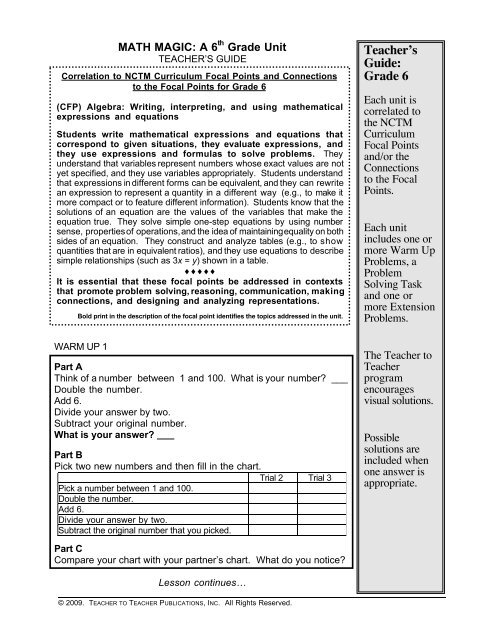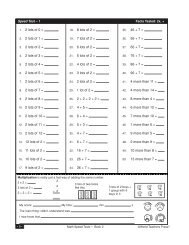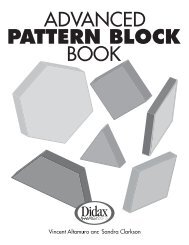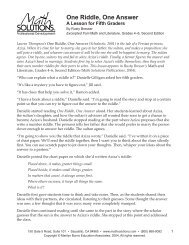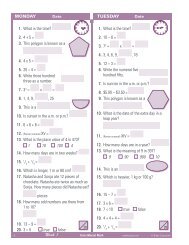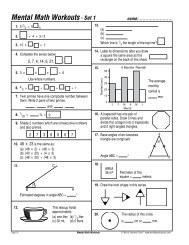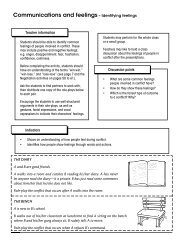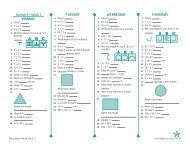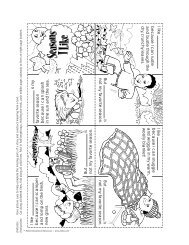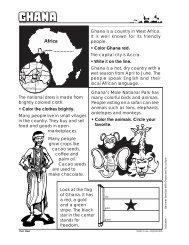Teacher's Guide: Grade 6
Teacher's Guide: Grade 6
Teacher's Guide: Grade 6
Create successful ePaper yourself
Turn your PDF publications into a flip-book with our unique Google optimized e-Paper software.
MATH MAGIC: A 6 th <strong>Grade</strong> UnitTEACHER’S GUIDECorrelation to NCTM Curriculum Focal Points and Connectionsto the Focal Points for <strong>Grade</strong> 6(CFP) Algebra: Writing, interpreting, and using mathematicalexpressions and equationsStudents write mathematical expressions and equations thatcorrespond to given situations, they evaluate expressions, andthey use expressions and formulas to solve problems. Theyunderstand that variables represent numbers whose exact values are notyet specified, and they use variables appropriately. Students understandthat expressions in different forms can be equivalent, and they can rewritean expression to represent a quantity in a different way (e.g., to make itmore compact or to feature different information). Students know that thesolutions of an equation are the values of the variables that make theequation true. They solve simple one-step equations by using numbersense, properties of operations, and the idea of maintaining equality on bothsides of an equation. They construct and analyze tables (e.g., to showquantities that are in equivalent ratios), and they use equations to describesimple relationships (such as 3x = y) shown in a table.♦♦♦♦♦It is essential that these focal points be addressed in contextsthat promote problem solving, reasoning, communication, makingconnections, and designing and analyzing representations.Bold print in the description of the focal point identifies the topics addressed in the unit.Teacher’s<strong>Guide</strong>:<strong>Grade</strong> 6Each unit iscorrelated tothe NCTMCurriculumFocal Pointsand/or theConnectionsto the FocalPoints.Each unitincludes one ormore Warm UpProblems, aProblemSolving Taskand one ormore ExtensionProblems.WARM UP 1Part AThink of a number between 1 and 100. What is your number? ___Double the number.Add 6.Divide your answer by two.Subtract your original number.What is your answer?Part BPick two new numbers and then fill in the chart.Trial 2 Trial 3Pick a number between 1 and 100.Double the number.Add 6.Divide your answer by two.Subtract the original number that you picked.The Teacher toTeacherprogramencouragesvisual solutions.Possiblesolutions areincluded whenone answer isappropriate.Part CCompare your chart with your partner’s chart. What do you notice?Lesson continues…© 2009. TEACHER TO TEACHER PUBLICATIONS, INC. All Rights Reserved.
WARM UP 2Now make a pictorial representation of the problem fromWarm Up 1.Use a single tile to represent your “mystery number”.Use another color of tiles to represent numbers that you add to orsubtract from your mystery number.Think of a number between 1 and 100.Double the number.Add 6.Divide your answer by two.Subtract the original number.What is your answer? _____________Teacher’s<strong>Guide</strong>:<strong>Grade</strong> 6(continued)Pages havebeen reduced insize andcombined forthis samplefolder.Note: Warm Up 3 continues work with pictorial representations.PROBLEM SOLVING TASKPart AFollow the directions in the first column for three trials withdifferent “mystery numbers” of your choice. Record what ishappening to each number as it goes through the steps.Part BDraw a pictorial representation of each part of the directions.Part CWrite an algebraic expression for each part of the directions.DirectionsPick any“mysterynumber”between 1and 100.Add 4 to it.Trial1Trial2Trial3PictorialRepresentationAlgebraicExpressionEach unitincludes blackline masters ofeach problemwith permissionfor oneclassroomteacher to makecopies forhis/her students.Add the“mysterynumber” toyour sum.Divide bytwo.Subtractyour“mysterynumber”.Answer:© 2009. TEACHER TO TEACHER PUBLICATIONS, INC. All Rights Reserved.
Problem Solving Task SuggestionsAsk students to:• Clarify what they need to do to solve the problem with a partner.Identify known and unknown information.Visit groups during work time to observe and ask questions thatdraw out student reasoning. Help students connect their “mysterynumber” to an “unknown” and to the term “variable”. Connectingthese terms will be extremely beneficial to the students as theywork with more abstract problems.Note: Lesson continues with suggestions for sharing solutions,increasing the cognitive demand and other recommendations.EXTENSION 1Teacher’s<strong>Guide</strong>:<strong>Grade</strong> 6(continued)Extensionproblems areincluded in eachunit for studentswho are readyfor additionalchallenges.Part AComplete the following table.PictorialRepresentationWritten DirectionPick a “mysterynumber” between 1and 100.AlgebraicExpressionThe range ofdifficulty, fromthe first WarmUp to thehardestExtension,providesappropriatechallengesfor students ofdiverse skilllevels.Result:Part BTest your algebraic expressions with several “mystery numbers”of your choice.Show your work.© 2009. TEACHER TO TEACHER PUBLICATIONS, INC. All Rights Reserved.
Sample (S/T) #1: Score 2G.9 MATH MAGICSample and Scored CommentaryThe response shows a clear understanding of the numeric parts ofthe task. However, in both the pictorial and algebraic columns thestudent’s partial understanding shows, beginning with the “divide bytwo” step. The work does always get the result of 2, but in both thepictorial and algebraic columns this comes from the numeric work,not the steps above.Sample (S/T) # 2Score: 2T/PJSTeacher’s<strong>Guide</strong>:<strong>Grade</strong> 6(continued)Each ProblemSolving Taskhas severalsamples ofstudent workwith scoredcommentariesbased on anindividualrubric.The samples,commentariesand individualrubrics assistteachers inevaluating thework of theirstudents.The scoredsamples andcommentariesalso helpstudents learnhow to evaluatetheir own workon ProblemSolving Tasks.© 2009. TEACHER TO TEACHER PUBLICATIONS, INC. All Rights Reserved.
“FIX IT!”G.9 MATH MAGICDIRECTIONS: CHANGE OR ADD TO THE WORK BELOW TO IMPROVE THE FINAL SCORE.T/PJSTeacher’s<strong>Guide</strong>:<strong>Grade</strong> 6(continued)After a class hascompleted aunit, the “FixIt!” activity cangive studentspractice inrevising andimproving awork sample.The job of thestudent in theseexercises is toanalyze whatmakes sense inthe sample andwhat needschanging, andthen to fix andcomplete thesolution.___________TEACHER SELF-EVALUATION FORMCheck the strategies you used in this unit and note what you said or did.WAYS TO HELP STUDENTS MAKE SENSEOF PROBLEM SOLVING• Be aware of the mathematics embedded in eachunit—Warm Up(s), Task and Extension(s)—soyou can engage students in discussions thatwill deepen mathematical understanding.• Encourage visualization of solutions, especiallywith the use of manipulatives.• Encourage students to rely on their own andeach other’s thinking.• Ask students to reference the criteria of theproblem to stimulate discovery of necessaryinformation and/or insight.√WHAT I SAIDOR DIDThe TeacherSelf-EvaluationForm isincluded at theend of eachunit. It canassist teachersas they learn toincorporatetheseinstructionalstrategies intotheir dailyproblem-solvinglessons.(Form continues…)© 2009. TEACHER TO TEACHER PUBLICATIONS, INC. All Rights Reserved.


